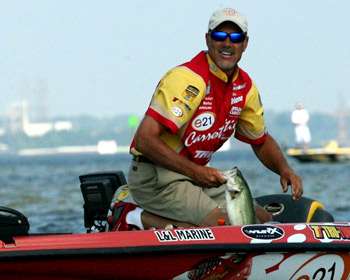
On first impression, it might seem like Boyd Duckett thinks that small balsa crankbaits like the Shad Rap are more trouble than they're worth: "You can't throw it but a yard and a half," he says, "and if there's a tree by it, it will swim to every limb. That thing can't come through anything."
But first impressions can be deceiving, he adds, noting that "if you can stand to learn how to put up with the fact that it will get hung, it's worth it. The No. 5 Shad Rap is probably the fish-catchingest crankbait ever made. I've never found a crankbait that will catch more fish than that little Shad Rap."
While he's well-known for his skills as a power fisherman, Duckett notes that in clear water lakes, particularly when the bite is difficult or otherwise off, a subtle, non-rattling crankbait can be the ticket to winning catches. While there are a variety of flat-sided and lightweight cranks in his boat, the Shad Rap is his "go to" in those conditions, and has been for a long time. No matter which particular bait you choose, it should be one "with a tight wobble to imitate a shad. You don't want a big, heavy vibration. It should be fairly insignificant."
He dotes on it at two points during the year, once in the prespawn when the fish are likely to be spooky, and later in the fall, when they're actively feeding but may occasionally still be tough to catch.
"Early in the year, when they're finicky, it's a great way to catch prespawn spotted bass at Lake Martin and Smith Lake (both in Alabama)," he says. "You go in the backs of the creeks and catch those big females in February. I've won tournaments doing that."
He typically puts it away during the summer, but it's never far from his reach. He knows that later in the year it'll likely bail him out of a jam or two.
"It's extremely good in the fall, when they're chasing bait and they get real tuned in to the size of the baitfish," he says. "They can be schooling visibly on the surface — and everybody's had this happen on clear lakes to them — and you can throw a spinnerbait or a topwater or a Rat-L-Trap through them and you won't get a bite. You take a little tiny flat-sided crankbait or a Shad Rap and get upwind to make a long cast because those schoolers are spooky and funny, and you can catch fish forever with a bait like that."
As noted above, the lure's potato-chip like castability means you won't be able to throw it on your pool cue flipping sticks. Duckett favors a 6 1/2- or 7-foot spinning rod and a matching reel spooled with 6-pound line.
He favors natural shad patterns most of the time. After all, he only uses it where the water is relatively clear. "But when there's a little bit of a stain — not dirty by any means, just a little stain — I'll throw the crawfish pattern," he says.
Another limitation, largely fostered by the need to use light tackle, is that it's typically not something he'll use when trophy-sized fish are around.
"You could use it on Amistad," he adds. "It would be a great opportunity but the size of fish it attracts doesn't allow it. If you fished along down a good ditch on that lake with a No. 5 Shad Rap and 6-pound line, you would catch a ton of 'buck' bass but those won't help you win a tournament there."
When conditions are right and keepers are what he needs, he'll always have one tied on. Most of the time, it's a matter of making the right cast and then just slowly winding it back. Sometimes in the fall he'll rip it now and then, with intermittent pauses, but it's no more complicated than that. More often than not, it'll catch the attention of fish inclined to feed. While it may not be as exciting as flinging a lipless crankbait or flipping a big craw through mats, two presentations that he used to win the 2007 Bassmaster Classic, rest assured that this little gem has contributed mightily to Duckett's bottom line.





